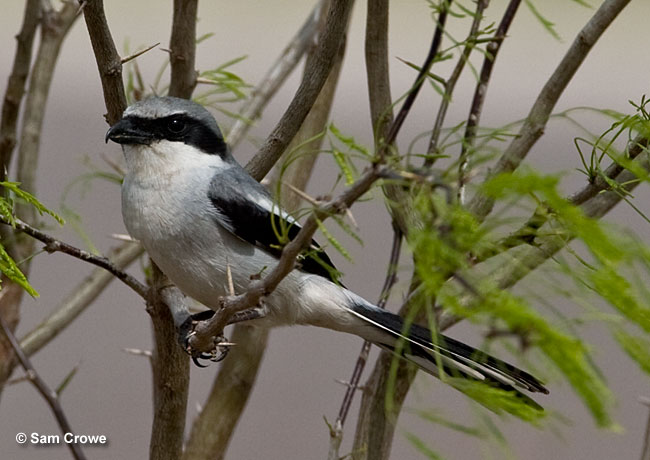Meet the Loggerhead Shrike (Lanius ludovicianus), also known as the butcherbird. These fierce birds are the only known predatory songbirds.
With a keen eye and a sharp, hooked bill, they perch atop fence posts and shrubs, scanning the landscape for their next meal. But what sets them apart is their unique habit of impaling prey—be it insects, small mammals, or even birds—on thorns or barbed wire.
On this page
Identification
Loggerhead Shrikes are medium-sized passerines measuring 7.9-10 inches long with a wingspan of 11-12.6 inches.
They have a distinctive appearance characterized by a compact, stocky build with a relatively large head in proportion to their body. Their wings are broad and rounded, suited for short flights and quick maneuvers. The tail is long and slightly rounded at the tip. Their black bills are thick and hooked.
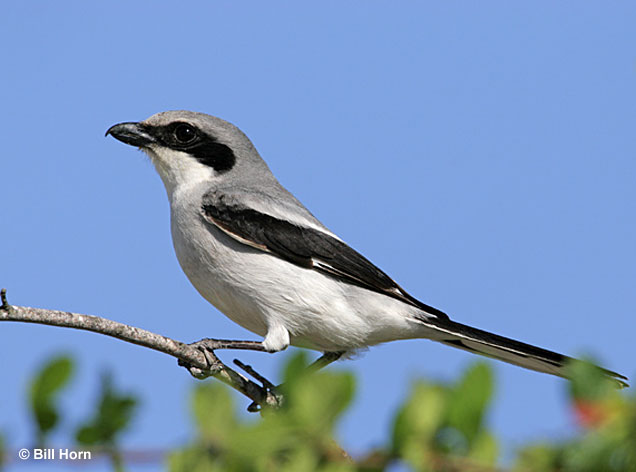
The bird’s plumage is a beautiful combination of white, black, and gray. They have a white underside and gray upperside. Their wings and tail are black. When the wings are folded, then they have a small white patch on them but when in flight, the patch is larger.
If the bird is flying and their tail is spread out, you can see that the outer feathers are white. The birds also have a black band running across their face, resembling a mask.
Juvenile Loggerhead Shrikes are slightly paler and more brownish. Overall, they have a similar plumage pattern, but their chests are also grayish-brown and they are faintly vermiculated, meaning that their feathers have faint fine barring. Their bills are slightly smaller and less hooked.
Vocalizations
The songs of Loggerhead Shrikes vary, but generally last for around or slightly longer than a second and consist of whistles, trills, buzzes, screeches, and warblers. Both males and females sing, and depending on the song, it can be described as sweet (such as warbles or whistles) or harsh (buzzes and screeches). The song often consists of two syllables, although trills and buzzes can be short single syllables.
Loggerhead Shrikes produce a variety of calls for different purposes, including nesting, mating, alarm, and territory defense. When startled, they emit a schgraa-a-a shriek and fan out their tails. Recently hatched nestling produce tcheek and tsp sounds. During courtship, females beg for food with mak notes while males offer with wuut or shack sounds.
Food
Loggerhead Shrieks are carnivorous and mainly feed on large insects and other arthropods, including grasshoppers, beetles, crickets, and wasps. However, they also feed on small mammals, reptiles, fish, and amphibians.
Their prey selection includes spiders, snails, various lizards, snakes, frogs, mice, voles, shrews, small fish, crayfish, and even birds such as sparrows and goldfinches. They tend to eat mostly insects during summer and focus more on small rodents in the winter.
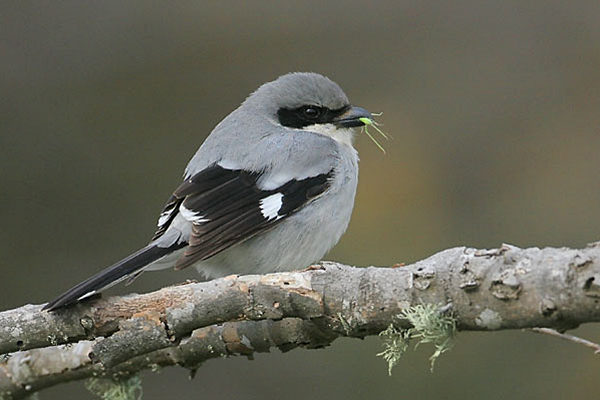
Loggerhead Shrikes use a sit-and-wait hunting strategy, perching on exposed vantage points such as fence posts, tree branches, or power lines. From these elevated positions, they scan their surroundings for potential prey.
When they spot something, they swoop down to capture it, and impale it with their bill. They sometimes also hover or hunt from the ground by startling their prey out of hiding by flashing their wings.
One of the distinctive behaviors of Loggerhead Shrikes is their habit of impaling prey on thorns, barbed wire, or other sharp objects.
They may do this to kill larger prey or store food for later consumption.
Nesting and Eggs
Loggerhead Shrieks are mostly monogamous for the breeding season. Courtship involves males singing and putting on a flight display for the female, where he flies rapidly up and down and chases the female, fanning out his tail and fluttering his wings.
If the female is interested she will respond with begging notes and a fluttering display, which invites the male to feed her.
Loggerhead Shrikes nest in semi-open areas, mostly in isolated or small clusters of dense, often thorny shrubs and trees 3-15, usually 3-4 feet above the ground.
If that is not possible, they may also nest on the ground in brush. The pair chooses the nesting site together. Males help gather materials while the female is responsible for building the nest. The nest is a bulky open cup made of twigs, rootlets, bark strips, and grasses and lined with softer materials, including hair, feathers, plant down, moss, lichen, or even flowers. It measures approximately 6 inches across and 3 inches deep.
A female can raise 1-2 broods in a breeding season with 4-8, mostly 5-6 eggs in a clutch. Loggerhead Shrike eggs are grayish buff and marked with gray to pale brown spots. They measure 0.9-1.1 inches long and 0.7-0.8 inches wide.
Incubation falls on the female and lasts for 15-17 days while the male feeds her. Both parents take care of their offspring. The young stay in the nest for about 17-21 days and are fed for another 3-4 weeks after that.
Current Situation
Loggerhead Shrikes range throughout North and Central America. They are year-round residents throughout most of the southern half of the United States and Mexico. Their breeding range extends further north to southernmost Canada whereas their wintering range further south into Mexico.
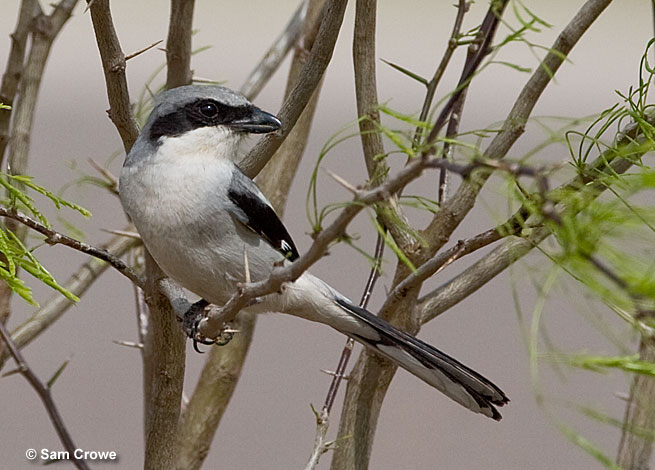
Loggerhead Shrikes inhabit semi-open areas with lookout perches like posts or scattered trees. This includes open pastures, grasslands, large clearings in wooded areas, deserts with scrubs or scattered trees, and other similar places. During winter they may opt for completely open areas provided there are posts or other similar perches for surveying the area.
Loggerhead Shrikes are listed as near threatened on the IUCN Red List. Their population is estimated to be around 7 million individuals, but their numbers are decreasing sharply. The main causes of this decrease seem to be pesticides, habitat fragmentation and loss, and urban development.
Facts
- Loggerhead Shrikes are the only known predatory songbirds. They can go for prey as large as themselves!
- Loggerhead Shrikes kill vertebrates by impaling their necks with their bills. It seems to be an instinctive behavior as parents do not demonstrate it to their young. However, the bird must do it at a certain point in their development, otherwise it will not learn to impale their prey.
- Loggerhead Shrikes also kill and eat venomous creatures from monarch butterflies to narrow-mouthed toads and even water adders. After killing them, they may wait up to three days to actually eat them to allow the poison to break down.
- Loggerhead Shrikes got their names from their disproportionately big heads since loggerhead is a synonym for a blockhead. They are also known as butcherbirds.
Similar Species
Loggerhead Shrikes have one nearly identical species – the Northern Shrike. Other than that, there are only a few fairly similar species that you can tell apart if you get a good look at them. Here they are and some tips on how to tell them apart.
Northern Shrike
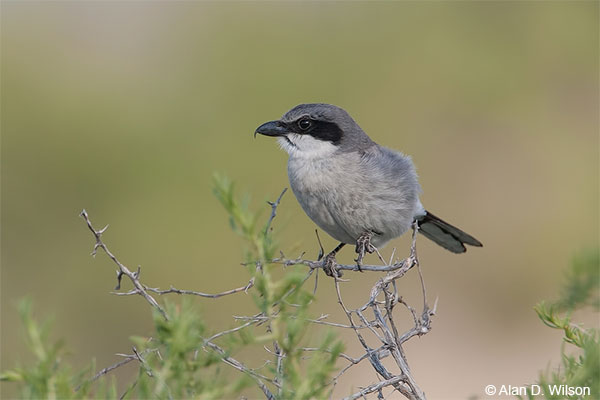
© Alan D. Wilson
Northern Shrikes breed in the northernmost North America, including Alaska and Canada, and winter in the northern half of the United States and the southern ranges of Canada. Adults are gray above and white below with fine gray barring on the breast. They have black wings and tails and a black mask. Immatures are brownish rather than gray.
Northern Shrike’s face mask is narrower and they have fine barring on the chest whereas adult Loggerhead Shrikes do not have any barring. Juvenile Loggerhead Shrikes have barring as well, but they also have a grayish-brown chest.
Northern Mockingbird
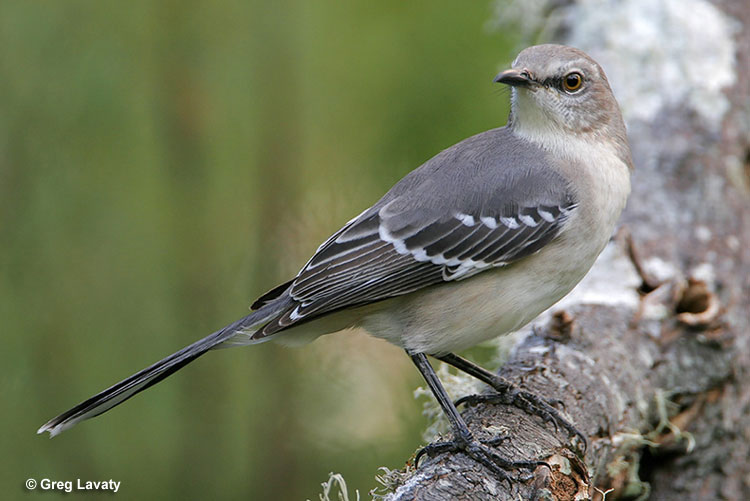
Northern Mockingbird is a year-round resident throughout the United States and most of Mexico. Adults are gray above, white below, and have black wings with two white wing bars and black tails. Their bills are black and fairly straight with a slight downcurve. They also have a faint black stripe running from the base of their bill to their eye.
Northern Mockingbirds are more proportionate compared to Loggerhead Shrikes and have smaller, more rounded heads and no hook in their bill. They lack the black face mask Loggerhead Shrikes have and have white wingbars instead of white patches.
Townsend’s Solitaire
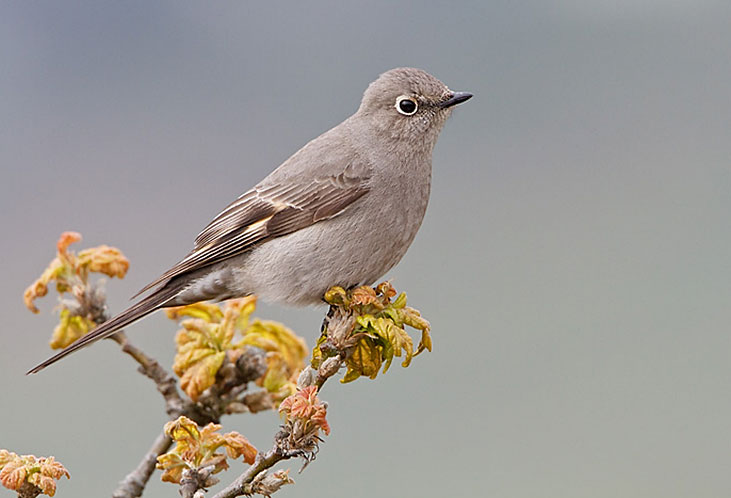
Townsend’s Solitaire can be found throughout western North America. There are resident populations throughout the western United States. The breeding range extends to Alaska and Canada. Adults are gray all over with buffy patches in the wings and white rings around the eyes. Their bills are short, straight, and black. Juveniles are dark gray with heavy buff-and-white spotting.
Townsend’s Solitaire is more proportionate and has a smaller and more rounded head compared to the Loggerhead Shrike. Their bills are smaller and don’t have a hook and they are uniformly gray without the black-and-white markings of the Loggerhead Shrike.
Frequently Asked Questions
How aggressive are shrikes?
Shrikes are aggressive and territorial throughout the year, attacking other species as well as their own.
Why is the shrike called the butcher bird?
Loggerhead Shrikes are called butcherbirds because they impale their prey on sharp objects.
Why do shrikes impale their prey?
Shrikes impale their prey to store it for later consumption.
How big is the Loggerhead Shrike?
Loggerhead Shrikes are medium-sized birds, measuring roughly 8-10 inches long.

